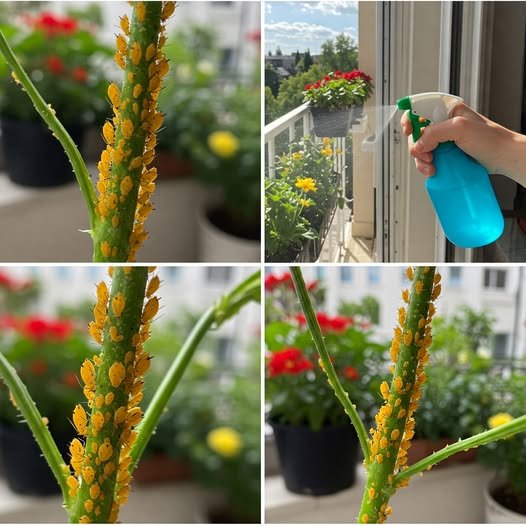Every year in the spring, aphids become a major problem for gardeners, attacking the leaves of vegetables, fruit trees, and flowers. This year, they have appeared particularly early, likely due to favorable climatic conditions. Aphids thrive in moist environments and become especially invasive after rain. Among the plants in my garden, they seem to attack the roses first. Their primary targets are young leaves, buds, and flowers, which can become severely damaged if left untreated.
Aphids come in many different colors, ranging from white, green, and black to brown. Interestingly, they have natural allies in ants. Initially, I believed that ants were feeding on aphids, but I soon realized the opposite was true. Ants protect aphids because they feed on the sweet, sticky liquid secreted by these pests. This symbiotic relationship allows aphids to multiply rapidly while ants act as their defenders against natural predators such as ladybugs.
To protect my plants, I knew I had to find a way to get rid of aphids. However, I prefer to avoid toxic pesticides, especially since my plants are in the yard and on the terrace where I spend a lot of my free time. Fortunately, various natural remedies can be used against aphids. Some commonly known options include nettles, tobacco, hot pepper, garlic, and neem oil. While these methods may offer some relief, none of them are completely effective on their own. After years of trial and error, I discovered that wood ash is one of the best natural solutions for controlling plant lice.
If you use wood for heating or enjoy outdoor barbecues, you likely have access to wood ash. Instead of discarding it, you can save a small amount for use as an aphid repellent. To prepare an ash solution, I dissolve 100 grams of wood ash in two liters of water. For added effectiveness, I sometimes include a few drops of biodegradable dishwashing detergent. This helps the solution stick to the plants more effectively and ensures that it remains on the leaves for a longer period.
After mixing the solution thoroughly, I allow it to sit for a few hours before straining it through a thick strainer or a piece of cloth. Filtering is important to prevent the sprayer from getting clogged. Once the solution is ready, I pour it into a sprayer and begin treating my roses, ensuring even coverage on all affected areas.
From my experience, ash is highly effective when used correctly. It is safe for plants when properly diluted and does not pose any health risks to humans or pets. Depending on the severity of the infestation, you may need to increase the amount of ash and water proportionally. After applying the first treatment, I observed that the aphids were still present but in significantly smaller numbers. This confirmed that while the solution works, a single application is often not enough.
To completely eradicate the aphids, I repeated the treatment after a few days. Within a short time, the aphids had disappeared entirely from my roses. However, one important thing to remember is that rain can wash the ash off the plants, reducing its effectiveness. If rain occurs shortly after application, the treatment should be repeated to maintain protection.
What makes wood ash particularly valuable is that it can be used in organic vegetable cultivation. Unlike chemical pesticides, it does not introduce harmful substances into the soil or the surrounding environment. Additionally, wood ash contains potassium and other minerals that can enhance soil fertility, providing additional benefits to your plants.
In conclusion, aphids can be a persistent and frustrating problem, but natural remedies like wood ash offer a safe and effective solution. While other methods such as neem oil and garlic sprays may help, wood ash has proven to be the most reliable in my experience. By preparing and applying the ash solution properly, you can keep aphids at bay while maintaining a healthy and organic garden. If you’re struggling with plant lice this season, I highly recommend giving wood ash a try.



